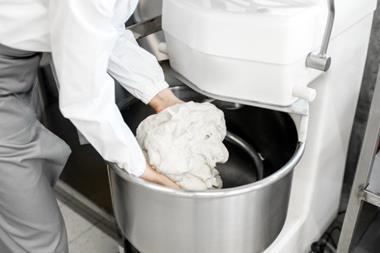In part five of the Bakery Project, we explore how to develop and adapt ranges to maximise sales
The shining stars of any bakery are its products. Customers live for the sight – and smell – of rows of freshly-baked loaves, cakes and buns, so ensuring you stock a good range of products is vital.
This, inevitably, varies from bakery to bakery and even locations within the same company. So how do you decide on the bread and butter of your business? Should loaves take centre stage, or is the spotlight reserved for something sweeter? And, with what’s in fashion forever changing, how do you stay relevant?
A selection of breads, traditional cakes and treats such as brownies are likely to make an appearance in most portfolios, but think carefully about the occasions for which customers will visit the bakery.
“There are a few items that are automatic, especially if they are trying to attract breakfast customers,” believes Terry Morgan, director at London’s Debaere, which provides pastries and desserts to coffee shops, retailers and bakeries.
“Croissants and Danish pastries are always a good start in this instance, then we try to look at creating a good mix of products for them to draw from so they can always have a staple, such as Victoria sponge, and then have specials from time to time.”
Bristol-based Pinkmans needed a menu that could work for breakfast, lunch, afternoon and through to the evening.
“The concept was an all-day menu based around bread-making and baking and the oven,” says Steven Whibley, co-founder of the bakery. “This gave us a good range, but also kept a purity to the menu. The challenge was to combine three kitchen sections – bread, patisserie and savoury – so they complemented each other.”
Items on Pinkmans’ menu include slow-fermentation sourdoughs – white, country cob, seeded sour and baguettes – with a heavy focus on toast and bacon sandwiches at breakfast alongside sweeter items such as brioches. Filled focaccia and ciabatta complement soups and stews at lunch, with traditional afternoon tea fare served later.
“We felt the evenings needed a simple idea to work – ‘it’s pizza!’. With ovens and dough-making being central and most of the ingredients already in the menu, it was not a big stretch,” he adds.
Just because something doesn’t fit into the workflow of your kitchen, doesn’t mean you can’t sell it. Many bakers opt to buy in lines from specialists rather than shell out on new equipment or dedicate the time to producing certain items. This is also a good option for those catering to specialist diets, such as gluten free, which is regulated strictly (see box out p26).
%%Quote_32%%
“Croissants and Danish pastries are much easier to source as they take a long time to make,” adds Morgan. “Typically –with mixing, shaping, proving, baking and cooling – they can take up to 12 hours. Also, a lot of cafés have limited kitchen space, so buying in complete products makes sense.”
Reading-based Warings Bakery, which was established in 1932, buys in hot savoury pies and sausage rolls.
“This is purely due to production restraints as we neither have the facilities nor equipment to produce in accordance with the law,” explains Daniel Carr, PR manager at Warings.
For Joe’s Bakery in Bristol, meat savoury pastries are by far the largest group of bought-in products. They come from a variety of suppliers, offering consumers different price points, and most are bought frozen raw, then baked-off in the shop.
“We use Warrens for our Cornish pasties and Penny Lane Foods for sausage rolls and savoury slices. Premium pies and sausage rolls are purchased from a local butcher who has recently established a pie and sausage roll facility. These are starting to sell very well, even though they are sold at premium prices,” explains Martin Hunt of Joe’s Bakery.
Products from Clark’s Pies, a long-established Bristol pie bakery, are also stocked, alongside bhajis and samosas purchased fresh from a local supplier, which Hunt believes differentiates it from the supermarkets.
“Our shop is situated in an area with a wide-ranging customer base and our bought-in product range reflects that mix,” he says. “Most of the savouries are eaten out of home and we have a large number of customers who buy daily or very frequently. In order to help prevent menu boredom, we offer a wide range of products and price marks, including a very competitive meal deal.”
Another way to prevent menu boredom is to innovate. But knowing which trends to tap can be tricky as there’s a careful balance to be struck between weird and wonderful and just plain weird.
“Innovation needs to be built into the structure of the business for it to work,” explains Whibley. Because of this, Pinkmans has many seasonal and monthly variations of basic items, such as doughnuts, sweet tarts and special breads. “We thinks it’s important to give the customer a mix of changing items and steadfast classics,” Whibley adds.
Warings, meanwhile, considers all of its NPD to be a temporary addition to the range unless the sales convince otherwise. “We never consider a new product to be a permanent line,” says Carr. “Instead it’s used to enhance the range, add interest, offer an alternative, reflect the seasons and, hopefully, encourage additional impulse sales. If a product proves very popular, then we may decide to add it permanently, for example our Mars Bar slice which is now one of our best-sellers.”
This method also has other benefits, notes Hunt from Joe’s Bakery. “Suitable products are put on sale as a ‘special’ or ‘seasonal’, or sometimes included in one of our national or British regional months. This gives us the opportunity to withdraw the line if it is not too successful without it looking like a failure,” he says. “A decision is then made on whether to carry on producing the line and whether it should be a daily, two/three-times a week or as a weekend special.”
Hunt suggests monitoring trends across a variety of mediums, whether TV shows, newspaper supplements, social media or by getting out and about. The street food scene, in particular, is lucrative when it comes to recipe inspiration.
Maximising information from food ingredients manufacturers and suppliers, he adds, is also valuable as they can provide a wider view of the market and trends within it and help deliver products in keeping with them. He advises bakers to also look at the trends impacting the wider food and drink market, particularly health-based ones, as, in many cases, it’s only a matter of time before it influences the bakery market.
%%Quote_33%%
It’s not always a case of looking for the next new thing, either. “Quite a lot of the time we find that it’s old favourites making a comeback, a forgotten star of the past or for nostalgia,” says Warings’ Carr. “Of course, for us that’s great, we can just dust off one of our tried-and-tested recipes and hit the ground running.”
Not all trends are equal and some won’t have the longevity that has been seen with cupcakes, premium doughnuts and even unicorns. Monitor your sales, advises Whibley, adding that any products selling under 10 a day would be under scrutiny.
“Normally, we monitor the sales of products that are in decline and either try to revitalise sales by making improvements, or we may put it on sale just two or three times a week,” says Hunt, noting it comes down to old-fashioned judgement.
While profitability is crucial, not all lines have to sell like hot cakes.
“We will sometimes continue to produce a slow-selling line if it provides benefits other than simply profit. Such benefits may be breads that have a ‘wow’ factor when on display, or breads that appeal to members of particular nationalities who come in for their own ‘national’ bread, but spend good money on other products as well,” says Hunt.
Speak to your customers, find out what they want, adapt and deliver.
21st century snacking: popcorn, fruit and premium crisps
Snacks have come a long way from shoppers grabbing a packet of salt and vinegar crisps to go with their lunchtime sausage roll.
While there is still a role for standard crisps in the traditional popular flavours, snacking is being transformed by trends that are also impacting the wider bakery market: health and premiumisation.
Vhari Russell, founder of The Food Marketing expert, suggests bakers offer a variety of products, such as popcorn, crisps, fruit snacks, and fruit.
“It would be great to ensure you offer something different to stand out, and source locally if you can,” she says, advising businesses should avoid large minimum orders and consider using a distributor to reduce administration.
Quality and provenance of ingredients has become all-important, according to Katy Hamblin, marketing manager of Pipers Crisps. “Consumers are actively seeking great-tasting snacks in preference to mediocre, commonplace fare whenever there’s a choice.
The good news is that consumers are willing to pay more for the right snack. “For them, it’s not about the price; much more important is the value they get from the quality of the food and the brand itself,” says Hamblin. “This is excellent news for bakers and café owners as it creates an opportunity to make a real point of difference by premiumising your offer.”
When it comes to health, Britain’s biggest crisps brand, Walkers, is tapping the trend with launches such as Sunbites Nut Mixes, containing dried fruit and nuts, as well as seasoned nut mixes, and Snack-a-Jacks mini rice cakes.
Pipers, meanwhile, recently launched Pipers Crispeas, based on British peas that are naturally low in calories and a source of protein and fibre. “It is a must to offer healthier lines and products specific to kids,” says Russell. “It is important to offer variety and products to encourage healthier living.”
Sales will be driven by stocking brands with a strong shelf presence, say suppliers.
“Eye-catching packaging backed up by a dependable brand name and impeccable credentials are important,” says Hamblin, adding that branded point-of-sale materials and equipment can help to promote snacks.
Russell suggests allowing shoppers to sample snacks to encourage purchase, and keeping merchandising simple, with wooden crates or baskets to display products near the counter.
Rising to the challenge of gluten-free
The gluten-free juggernaut shows no sign of slowing, with supermarket sales of gluten-free baked goods up 17.5% year-on-year in 2017 [Kantar Worldpanel]. And businesses are continuing to invest in the market, with Village Bakery just announcing development of a £12m free-from factory (see p4).
But for a bakery hoping to take a slice of the burgeoning market for itself, there are major obstacles.
“The problem with gluten-free products is that wheat gives you everything you need for baking,” says Małgorzata Gieblewicz, marketing manager at The Polish Bakery, adding that ensuring taste and quality were not compromised was a priority for the business when it expanded into gluten-free goods.
“The process of gluten-free baking is much more complicated, so there is a technical challenge. To achieve similar results you need a mixture of starch, proteins and gluten-free flour, and finding the best possible certified suppliers was a time-consuming process.”
As for the issue of cross-contamination with gluten-containing goods and ingredients, The Polish Bakery opted to produce its free-from bread in a separate facility, as many manufacturers do. In addition, the business has segregated storage areas, invested in specialist training for staff producing the free-from goods, and undertakes regular testing.
Gail’s Bakery also has a dedicated facility for its gluten-free sourdough. The business adds that getting a good crust and great taste has proved difficult but has been achieved by using a blend of gluten-free flours.
For many businesses, sourcing gluten-free products from a third party is the solution to catering for special dietary needs.
“Our bought-in items include gluten-free bread and confectionery from a local family bakery with a specialist production room,” explains Martin Hunt of Joe’s Bakery in Bristol.
But gluten-free isn’t for every business, as attested by Daniel Carr of Warings Bakery.
“We have tried, on several occasions, to tap into the gluten-free market, but as we’re unable to produce this ourselves, we had to buy in product,” he says.
“After several attempts, we came to the conclusion that consumers don’t consider their local family bakers on the high street as a gluten-free specialist, choosing dedicated gluten-free cafés, delis and bakeries or online retailers instead.”
Bean counting: the value of a good coffee offer
Brits down 95 million cups of coffee daily in the UK, according to the British Coffee Association, so little wonder hot beverages are an important part of most bakery retailers’ offer.
“Consumers want the convenience of a one-stop shop to be able to get their food and drink at the same time,” says Daniel Carr, PR manager at Warings Bakery, Reading.
Coffee and tea are an essential part of any eat-in offer, believes Steven Whibley, founder of Bristol’s PInkmans Bakery. “Having a beverage offer to match the quality of the food menu was always a key part of our concept,” he says, adding that his business is also seeing strong growth in sales of fruit and veg juices produced on-site.
Hot beverages can boost local sourcing credentials, with Sussex bakery business Foodhaven buying from a local roastery. Bristol-based Joe’s Bakery uses a well-established local coffee roaster, Brian Wogan, to match the quality of the large number of nearby coffee shops.
“Until last year we used a different supplier and a beans-to-cup machine, but realised that we had to up our game,” explains owner Martin Hunt.
“We didn’t hesitate to go to Wogan [Coffee] for a barista-style machine and coffee. They provided us with excellent help, guidance and training, as well as great coffee, of course.”
Being trained in the art of coffee-making is becoming an increasingly integral skill as competition in the coffee market grows, says Barry Kither, away-from-home sales and marketing director at Lavazza UK.
He adds, however, that technology means it is now possible to serve barista-quality coffee without employing barista-qualified staff. Capsule-based solutions – the fastest-growing part of the Lavazza offer – means business can offer consistent quality in a cost-effective way, he claims.
“In addition to this, the equipment Lavazza supplies has a temperature-controlled steam arm, which is a key element for non-specialists in the coffee sector as the milk foaming element is a tricky skill to master,” says Kither.
Warings Bakery is currently sourcing a new supplier for its coffee and machines, a process it is taking great care with. “It’s a long process, as I’m finding out, with copious amounts of coffee drinking. Coffee is still on-trend and consumers know what they like,” says Carr.
“We want to find a company that has the same values as ourselves and mirrors the care and quality of its product and services as we do.”


























No comments yet